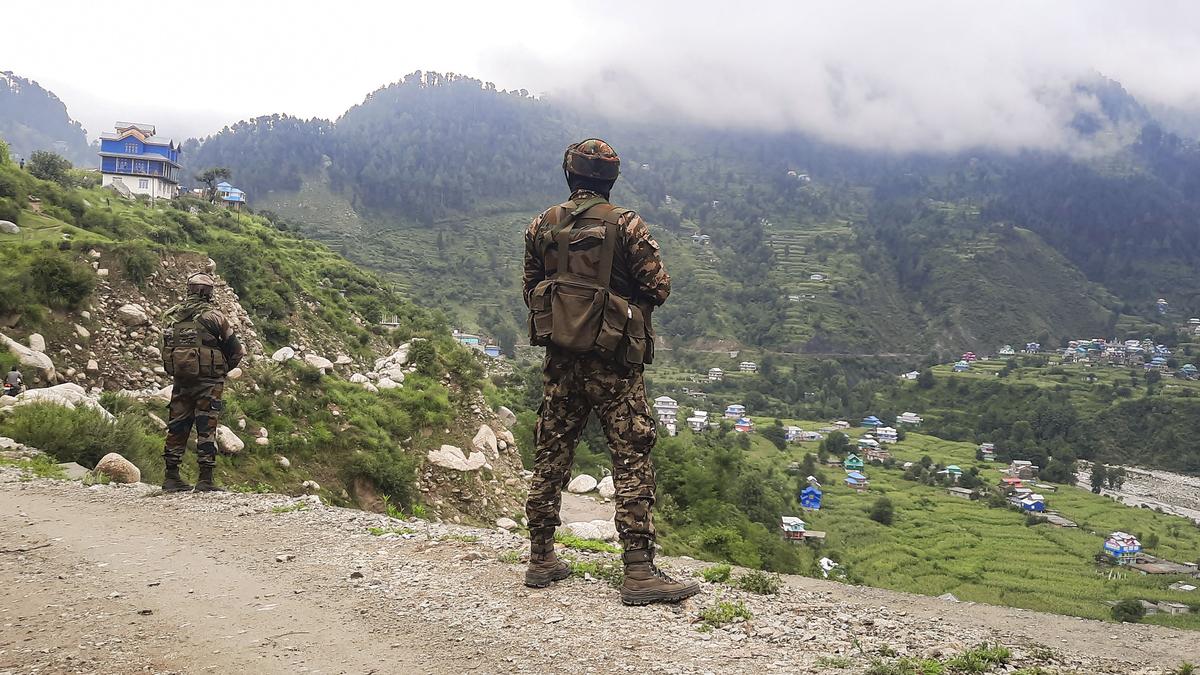‘The establishment of a grid is based on threat perceptions carried out by the Army’
| Photo Credit: PTI
For the last couple of years, the Jammu region has been in the news for all the wrong reasons, and more so over the last few months. Security forces have suffered irreparable losses in their pursuit of terrorists who are active — this includes freshly infiltrated cadres — and, as usual, backed by Pakistan. One of the major factors that emerged as the attribute was the weakened counter-terrorism grid resulting from troops from the Jammu region being re-deployed on the Line of Actual Control (LAC), following the Galwan incident of June 2020. In order to tide over this particular challenge, additional troops, to include Special Forces teams, have been inducted in the region to fill the void. This daily had a report on this, titled “Around 3,000 Army troops, 500 special forces inducted into Jammu area”, July 19, 2024).
Editorial | A new trend: On militancy in Jammu and Kashmir
Recently, news of Assam Rifles troops being inducted in the Jammu region to strengthen the counter-terror operations in the region has been reported by various news agencies, electronic and print. This daily had a report on this too — “CRPF to replace two battalions of Assam Rifles in Manipur; Kuki-Zo groups oppose the move”, August 1, 2024). These reports, obviously and correctly so, highlight the seriousness on the part of the government vis-à-vis the increasingly deteriorating security scenario in the entire Jammu region, from Kathua to Poonch and also the Chenab valley comprising Doda and the adjoining sub-regions. However, there are several connotations to inducting troops from outside the region towards beefing up the counter-terrorism grid.
Establishing a grid
A counter-terror deployment grid entails units and sub-units deployed in a manner to dominate the likely vulnerable areas that have the potential to offer terrorists freedom of movement. The establishment of a grid is based on threat perceptions carried out by the Army based on factors such as terrain, vulnerable areas, and even inclination of the local population, i.e., whether the population is supportive or otherwise. The sub-units, having been deployed as part of the grid, embark on the mission of hunting for terrorists by undertaking tactical operations based on psychological aspects such as people friendliness.
The knowledge of the terrain and winning the hearts and the minds of the people form the basis of operations mentioned above. Given the nature of the tasks at hand, the entire process is well thought through, deliberate and time consuming. Sub-unit commanders gain the confidence of the people by their operational conduct so as to get the local population on their side with the eventual aim of gaining information on terrorists who may be active in the area.
The challenges
As per the classical teaching of counter-insurgency/counter-terrorism, the local population is seen divided into three sub-sets. One minority sub-set each that supports the state and the terrorists, respectively, and a majority that is, by and large, neutral. The success of security forces depends on sustaining the support of the minority that they already have and winning over the neutral majority, thereby winning over two-thirds of the local population. The Indian Army has been combating insurgencies/terrorism based on operations by Infantry or Rashtriya Rifles units, deployed in a grid. The deployed grid in the hinterland supports the counter-infiltration deployment on the Line of Control, forming multi-tiered arrangements.
Rise in militancy in Jammu division in last three years
In the context of additional troops being inducted, it is noted that the newly-inducted troops shall have a challenging task at hand to orient themselves and settle down in the respective area of responsibility. In doing so, one has the inescapable requirements of knowing the area, knowing the local population and, most importantly, winning them over. It is much more than merely the mathematics of having an accretion. These challenges, to a certain extent, could be mitigated if the newly-inducted troops are superimposed on the already deployed units and sub-units rather than being deployed in an independent manner. As far as possible, the new body of troops in an area should be deployed as sub-units under the respective leaders, and not in a piecemeal manner aimed at numerical increase.
Operation Dudhi
Lastly, vis-à-vis the Assam Rifles unit that is likely to be deployed, and as reported in recent media reports, it is not the first time that Assam Rifles units are being inducted in Jammu and Kashmir. In the late 1980s and early 1990s, Assam Rifles units were deployed in the Valley and had performed gallantly as integral units. The successful Operation Dudhi, in May 1991, in the general area of Chowkibal by 7 Assam Rifles is still remembered as one of the most successful operations.
The hallmark of Operation Dudhi was that this was mainly conducted under the commanding officer of the battalion with his sub-units playing the major role. The major lessons that emerge are that commanding officers need to be trusted and allowed to control and conduct operations. However, of late, due to the relatively decreasing intensity of operations, any developing operation these days tends to go into the control of command beyond the battalion level, thus adversely affecting seamless control.
In a nutshell, an additional unit inducted needs to be deployed and tasked as an integral body of troops and must be allowed sufficient time to gain control in the new area, supported by the existing command structure of brigades/sectors — against a mathematical distribution and deployment that is bound to be counter productive. It has to be realised that the security forces are in this for a long haul, and expecting snap outcomes will be detrimental in all respects.
Colonel Shashank Ranjan is a retired Infantry officer with substantial experience of having operated in counter-terror operations in the Jammu region to include command of a Rashtriya Rifles battalion. He teaches at O.P. Jindal Global University, Sonepat, Haryana

